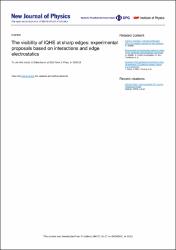| dc.contributor.author | Erkarslan, Uğur | |
| dc.contributor.author | Oylumluoğlu, Görkem | |
| dc.contributor.author | Grayson, M. | |
| dc.contributor.author | Siddiki, Afif | |
| dc.date.accessioned | 2020-11-20T16:22:35Z | |
| dc.date.available | 2020-11-20T16:22:35Z | |
| dc.date.issued | 2012 | |
| dc.identifier.issn | 1367-2630 | |
| dc.identifier.uri | https://doi.org/10.1088/1367-2630/14/2/023015 | |
| dc.identifier.uri | https://hdl.handle.net/20.500.12809/4164 | |
| dc.description | WOS: 000302304700005 | en_US |
| dc.description.abstract | The influence of the incompressible strips on the integer quantized Hall effect (IQHE) is investigated, considering a cleaved-edge overgrown (CEO) sample as an experimentally realizable sharp edge system. We propose a set of experiments to clarify the distinction between the large-sample limit when bulk disorder defines the IQHE plateau width and the small-sample limit smaller than the disorder correlation length, when self-consistent edge electrostatics define the IQHE plateau width. The large-sample or bulk quantized Hall (QH) regime is described by the usual localization picture, whereas the small-sample or edge regime is discussed within the compressible/incompressible strips picture, known as the screening theory of QH edges. Utilizing the unusually sharp edge profiles of the CEO samples, a Hall bar design is proposed to manipulate the edge potential profile from smooth to extremely sharp. By making use of a side-gate perpendicular to the two-dimensional electron system, it is shown that the plateau widths can be changed or even eliminated altogether. Hence, the visibility of IQHE is strongly influenced when adjusting the edge potential profile and/or changing the dc current direction under high currents in the nonlinear transport regime. As a second investigation, we consider two different types of ohmic contacts, namely highly transmitting (ideal) and highly reflecting (non-ideal) contacts. We show that if the injection contacts are non-ideal, but still ohmic, it is possible to measure directly the non-quantized transport taking place at the bulk of the CEO samples. The results of the experiments we propose will clarify the influence of the edge potential profile and the quality of the contacts, under QH conditions. | en_US |
| dc.description.sponsorship | TubitakTurkiye Bilimsel ve Teknolojik Arastirma Kurumu (TUBITAK) [109T083]; Istanbul University projects departmentIstanbul University [BAP-6970] | en_US |
| dc.description.sponsorship | We thank Huseyin Kaya for his support in organizing the first 'Akyaka Nano-electronics Symposium' and the Feza-Gursey Institute for the fourth, where this work was partially conducted. The I.T.A.P.-Marmaris is also acknowledged for organizing the winter school where the discussions on utilizing the CEO crystals were initiated. This work was partially supported by Tubitak (109T083) and the Istanbul University projects department (BAP-6970). | en_US |
| dc.item-language.iso | eng | en_US |
| dc.publisher | Iop Publishing Ltd | en_US |
| dc.item-rights | info:eu-repo/semantics/openAccess | en_US |
| dc.subject | Quantum hall regıme | en_US |
| dc.title | The visibility of IQHE at sharp edges: experimental proposals based on interactions and edge electrostatics | en_US |
| dc.item-type | article | en_US |
| dc.contributor.department | MÜ, Fen Fakültesi, Fizik Bölümü | en_US |
| dc.identifier.doi | 10.1088/1367-2630/14/2/023015 | |
| dc.identifier.volume | 14 | en_US |
| dc.relation.journal | New Journal of Physics | en_US |
| dc.relation.publicationcategory | Makale - Uluslararası Hakemli Dergi - Kurum Öğretim Elemanı | en_US |


















